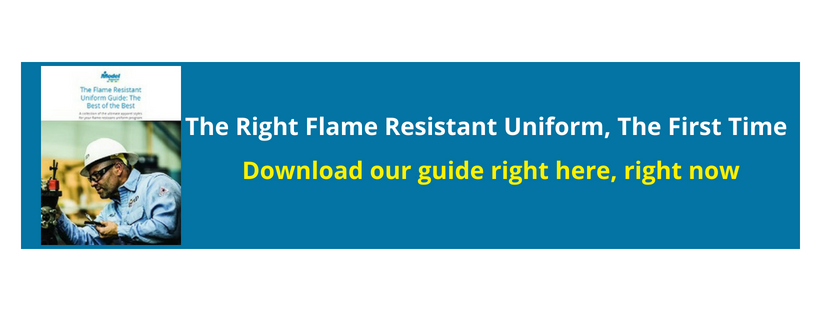It's been some time (6 years to be exact) since we've looked at flame resistant clothing trends. A lot has changed in that time, so we thought we'd bring an update.
Because workplace safety is a critical concern for many industries, and flame resistant clothing is our thing, we'll review the latest. It also helps that more and more industries requiring flame resistant clothing are looking for the latest in comfort for their teams.
In this article, we'll quickly review the history of flame resistant clothing. We'll then look at trends to see what's available now, including reviewing today's hottest products. We might even predict the future of flame resistant clothing technology. By understanding how this innovative technology can be applied in different contexts, we can better protect workplace safety across industries worldwide.
Intro to flame resistant (FR) clothing
Using flame-resistant (FR) clothing has been around for centuries, with the earliest examples being used in the form of wool and leather garments. Since the middle of the last century, flame resistant clothing design has worked to protect workers from sparks, flames, and heat when working in hazardous environments.
Over time, FR clothing technology has advanced significantly. Advancements are allowing for lighter fabrics that are more comfortable while still providing superior protection against fire and heat exposure. Today, FR clothing is essential in many industries such as oil and gas production, manufacturing plants, welding facilities, and chemical processing plants.
But when you think of advanced clothing technology, do you think of these environments first? People might think of these environments as dirty and undesirable. But as advancements in working conditions take place, so do improvements in the clothing these workers wear.
You can't overstate the importance of FR clothing. It not only helps protect employees from potential burns or other injuries, but also provides a layer of protection against workplace fires. In some cases, employers may require their staff to wear certified FR clothing to meet safety regulations or insurance requirements.
In recent years there have been significant advances in the materials used in FR clothing. Fabrics such as Nomex®, Kevlar®, Protera®,and Pyrotec™ have become popular due to their enhanced lightweight properties coupled with their excellent flame resistant qualities. The latest products on the market boast high levels of comfort. Thanks to advanced technology, they still offer superior protection against heat and flame exposure depending on the industry requirements.
Wider adoption of FR Clothing
Using flame resistant (FR) clothing is rapidly growing in prevalence due to the progress made in manufacturing lightweight and flame-resistant fabrics. There is now a heightened awareness of the need for fire safety. This need has resulted in FR clothing becoming a requirement for many industries, from oil and gas to medical and aerospace.
These developments have opened up new possibilities for FR clothing beyond just traditional hazardous workplaces such as power plants or refineries. This technology is used to craft garments specifically tailored for any industry that demands increased safety regulations - from lab coats to firefighter uniforms.
Additionally, advances in weaving processes are allowing companies to create fabrics that meet high standards while still preserving comfort levels.
Furthermore, developing coatings and treatments enhances protection against specific risks or threats. All these advancements mean that lighter weight materials can be used without sacrificing any of their flame resistant properties.
It is clear that FR clothing will remain a popular choice over the coming years. Due to its increasing use across numerous industries and its potential applications, FR clothing is becoming a household name. To provide ideal protection for your team, it is essential for you to keep up-to-date with the latest advancements within this field.
Industries where FR Clothing is dominant
We've highlighted industries where flame resistant clothing is prevalent. The more prominent ones are manufacturing, oil and gas, metal production, welding and firefighting. Regular exposure to extreme temperatures, electrical sparks and open flames are significant risks for these employees.
Manufacturing environments often face both open flame and electrical hazards from both electrical and natural gas-powered equipment. The oil and gas industry faces danger from sources of open flames that may ignite when exposed to natural gas or oil leaks. Metal production has increased risks due to open flames and extreme temperatures.
But are there additional, less well-known industries where FR clothing is becoming normalized?
Some instances in the medical field are one example. There are needs for those in the facilities management subset of the medical field. Employees that work on the machines to keep a hospital running obviously need protection from electrical arcs and open flames.
Aerospace is another example. The manufacturing of various materials used in exploring space pose a threat to workers. Open flames and metal fabrication are clear situations where FR clothing is necessary for workers.
With new environments for FR clothing popping up, what considerations must be made to what standards say about using this technology?
Standards for FR Clothing
With the ever-evolving nature of technology and regulations, standards for FR apparel must be regularly updated to provide maximum protection for workers. Who is driving this change?
Industry associations such as NFPA 2112 and ASTM F1506 are responsible for setting standards for FR clothing. These standards are regularly revised, and companies within these industries have additional responsibilities. They should make sure they are aware of the latest updates to make sure they remain compliant.
In addition to industry standards, governments may set their own rules which must be followed. One example is the US Department of Labor's Occupational Safety and Health Administration (OSHA). OSHA requires employers in certain industries to provide workers with FR clothing that meets their stated criteria. This is an example of an additional layer of safety regulation for the most applicable instances.
It's important for companies within high-risk industries to understand how these standards are being applied. These applications could mean life and death for your team. By staying up-to-date on the latest advancements, you can make sure your team has the best protective technologies available today—and into the future.
Products with the latest FR clothing technology
The aim of flame resistant (FR) clothing is to protect workers in hazardous environments. In recent years, advances in fabric technology have enabled manufacturers to create high-performance products that meet the needs of different industries. Here, we will explore the latest products with FR clothing technology.
The most prominent features of these materials are their weight and feel. Their weight is noticeably lighter than traditional FR clothing in similar styles. The feel is enhanced in some of these styles because of the fabric makeup. Blended fabrics, once thought impossible for providing FR protection, are now commonplace.
These products show the latest trends in FR clothing. If you'd like to know more about a certain style, reach out. We can even provide a sample for you to test for yourself!

Style: FR Flex Knit Henley
Colors: Khaki, Navy
Starting at: $82

Style: FR Flex Knit Tee Shirt
Colors: Khaki, Navy
Starting at: $84

Style: FR Flex Knit Button Down Work Shirt
Colors: Khaki, Navy
Starting at: $96

Style: FR Flex Knit Check Pattern Button Down Shirt
Colors: Charcoal, Navy
Starting at: $92

Style: FR Relaxed Fit Bootcut Stretch Jean
Colors: Denim
Starting at: $90

Style: FR Dungaree Stretch Denim
Colors: Denim
Starting at: $95
Future of FR clothing technology
We're not fans of making predictions, but the future of flame resistant clothing looks exceptionally promising. New materials and manufacturing techniques are being developed. Businesses and industries alike can look forward to lighter, more comfortable garments that offer enhanced levels of safety protection against electric arcs and flames. Advanced treatments are also being explored which can be applied to existing FR fabrics. These advancements will maximize their flame resistant properties in hazardous work environments.
Further, the potential application areas for these developments extend far beyond just traditional industries - ranging from medical to hospitality, even fashion. The challenge lies in making these advancements available at an accessible price. Our hope is that everyone can benefit without sacrificing quality or safety standards. In this regard, companies must remain proactive about innovating and setting new industry benchmarks for protective technologies that are both safe and affordable.
It is clear that flame resistant clothing technology has come a long way since its early days. We're certain that more advancements will be made in terms of comfort, performance and overall accessibility. You need only stay informed about the latest developments. This way, you can make sure your employees have access to the best protective apparel available on the market today.
Topics: Flame Resistant, Workwear, Workplace Safety
.png?width=621&height=373&name=Model-Apparel%20Logo%20File%20from%20Ian%20(1.2).png)
.png)

